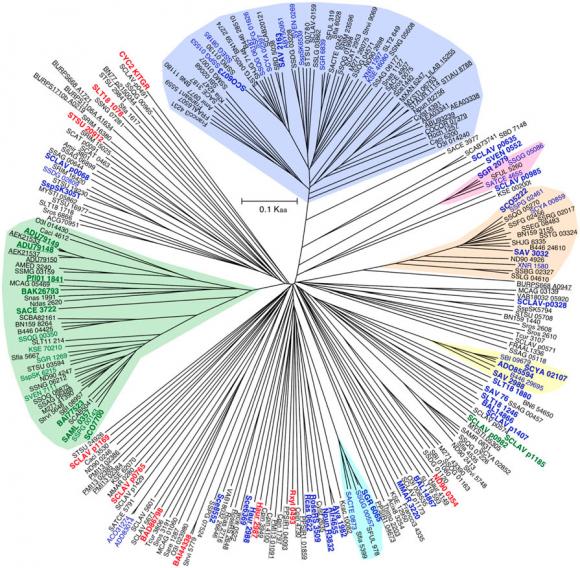PROVIDENCE, R.I. [Brown University] — If you’ve ever enjoyed the scent of a pine forest or sniffed a freshly cut basil leaf, then you’re familiar with terpenes. The compounds are responsible for the essential oils of plants and the resins of trees. Since the discovery of terpenes more than 150 years ago, scientists have isolated some 50,000 different terpene compounds derived from plants and fungi. Bacteria and other microorganisms are known to make terpenes too, but they’ve received much less study.
New research at Brown University, published in the Proceedings of the National Academy of Sciences, shows that the genetic capacity of bacteria to make terpenes is widespread. Using a specialized technique to sift through genomic databases for a variety of bacteria, the researchers found 262 gene sequences that likely code for terpene synthases — enzymes that catalyze the production terpenes. The researchers then used several of those enzymes to isolate 13 previously unidentified bacterial terpenes.
The findings suggest that bacteria “represent a fertile source for discovery of new natural products,” the researchers write.

“We can now use bacterial sequences, which should yield a greater degree of similarity. So now we’re fishing in the right waters with the right kind of bait.”
Photo: John Abromowski/Brown University
David Cane, a professor of chemistry at Brown and one of the authors on the new paper, began working about 15 years ago to understand how bacteria make terpenes.
“At that time, the first genomic sequences of certain classes of bacteria were just beginning to come out,” he said. “We had this idea that maybe you could find the enzymes responsible for making terpenes by looking at the sequences of the genes that were being discovered.”
To do that, Cane searched through the genome data gathered for a group of bacteria called Streptomyces, looking for sequences similar those known to produce terpene synthases in plants and fungi. Eventually, he found that Streptomyces did indeed have genes encoding terpene synthases and that those enzymes could be used to make terpenes.
The verified bacterial sequences found by Cane and others enabled researchers to refine subsequent searches for additional terpene synthase genes. “Instead of using plant sequences or fungal sequences as your search query, we can now use bacterial sequences, which should yield a greater degree of similarity,” he said. “So now we’re fishing in the right waters with the right kind of bait, and you can find more matches.”
This latest paper made use of the third generation of iterative searches and a powerful search technique developed by Haruo Ikeda of Kitasato University in Japan. Previous work had identified 140 probable sequences for terpene synthases. This latest work expanded that to 262.
The next step was to verify that these sequences did indeed code for enzymes capable of making terpenes. Testing all 262 wasn’t practical, so the team chose a few they thought might give them the best chance of finding terpene compounds that hadn’t previously been identified. They looked for sequences that didn’t seem to fit clearly into previously known categories of terpenes.
After they had selected a few, the team made use of a genetically engineered Streptomyces bacterium as a bio-refinery to generate the terpene products.
“What Professor Ikeda did, in collaboration with us, is develop a variant of a very well-studied Streptomyces system,” Cane said. “He eliminated the genes that were responsible for making most of its native products, but he left behind all of the capacity to provide the starting materials and handle the accumulation of products.”
By taking some of the gene sequences they found and splicing them into their test organism, the researchers could let the organisms generate the product using the instructions from the newly introduced gene. Using this method, they were able to make 13 previously unknown terpenes, their structures verified by mass spectrometry and nuclear magnetic resonance spectroscopy.
“It’s a big step forward in the area in that it provides a paradigm for how one could go about discovering many new substances,” Cane said. “It’s a good example of how one can use sequence analysis to identify genes of interest and then apply molecular genetic and microbiological techniques to produce the chemical substances of interest.”
The work also suggests that there may be many new terpene products as yet undiscovered hiding in the genomes of bacteria.
The work was supported by a National Institutes of Health grant to David Cane (GM30301). Other authors on the paper, in addition to Cane and Ikeda, were Yuuki Yamada, Tomohisa Kuzuyama, Mamoru Komatsu, Kazuo Shin-ya, and Satoshi Omura.

